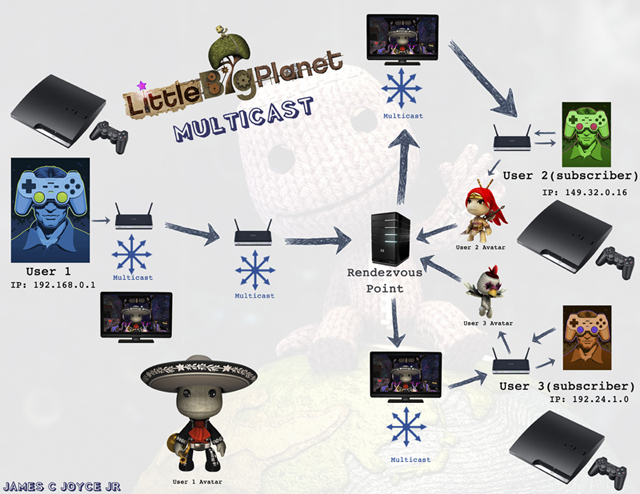Little-Big MulticastI will use the Playstation-3 game: "Little Big Planet" as a model to demonstrate the concept and use of multicast. My PS3 console connects to the Internet through a wireless router attached to a cable modem (physical layer). In order for multicast to function properly everyone subscribed to the multicast channel must have a multicast-enabled router. The online play-modes, and the ability to customize many aspects of the game, make this an ideal model for showing how multicast is utilized in the realm of video games. Multicast will allow my online subscribers to view the same content on their screen that I see on my screen, updated in real-time. Throughout the game, ones avatar collects various costumes and stickers, using them to customize outfits and decorate home base, known as your "Pod".

|
Here is the scenario: I have reached a part in the game that requires three people, working cooperatively, to complete a level. On this occasion I am playing alone and require the assistance of two online players to complete the task at hand. I begin by selecting the online game mode. My data link must check for any errors that occur in the connection to the Internet through the physical channel (in this case, my modem, and wireless router connection). The network must determine logical addressing to make this connection, or more simply, how to route my information from point A to point B. The Transport layer is responsible for ensuring that this information arrives, and does so by regulating the number of packets streaming through the determined channel. My information, including all pod and character customizations, will hop from my router (Internet Protocol Version 4 address: 192.68.0.1) to several more routers to reach a "rendezvous point" on this pre-determined path. Each router will have its own unique IP address. Simultaneously my online subscribers will be completing their own hops through several other routers to reach the same rendezvous point. The subscribers must send a "join-group" request through Internet routers. The routers then forward this information to the multicast routers, which builds a distribution channel for all subscribers. Each online player has their own unique "IPv4" addresses assigned to them. The multicast routers subscribe to multicast addresses that will communicate all traffic to the multicast router to the unique local addresses. IP addresses are composed of four packets of numbers representing bytes valued from 0-255 (each packet must be represented through these numbers individually, or added together: 128, 64, 32, 16, 8, 4, 2, 1, 0). As we all "arrive" at the negotiated multicast addresses for our game play, our game play information is broadcast to each other on the multicast channels that have been secured for use by all players subscribed to the game session. This important multicast function reliably ensures that all subscribers view the same information displayed on their screens simultaneously. The session layer opens, and maintains all the multicast channels for the duration of this online game, ensuring that no subscriber will be unexpectedly dropped from game-play, or misses crucial information transmission. The Presentation layer converts game play information into a format that is easily transported over the path. This information is reinterpreted at the destination into a format that is easily understood, and presented on each receiver’s screen. Lastly the Application layer is the user interface part in the equation, which allows the players to see this information interpreted and displayed on their screens as an enjoyable cooperative game. Happy Cooperative-Gaming, made possible by all layers of the OSI Model! |